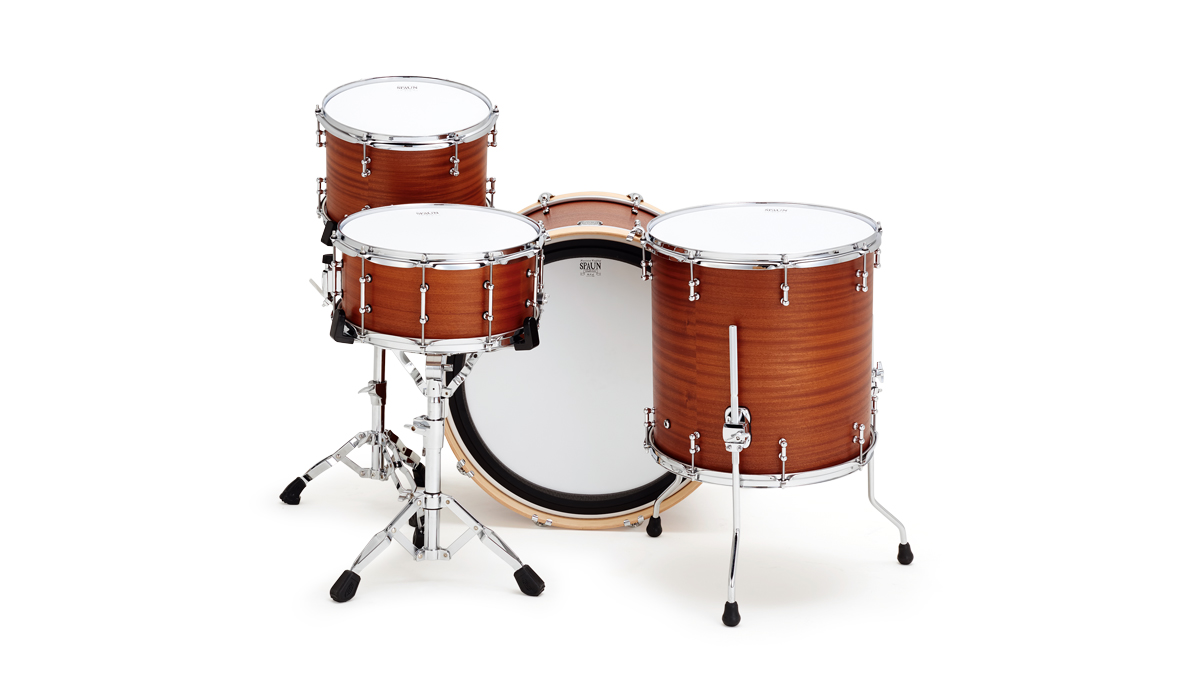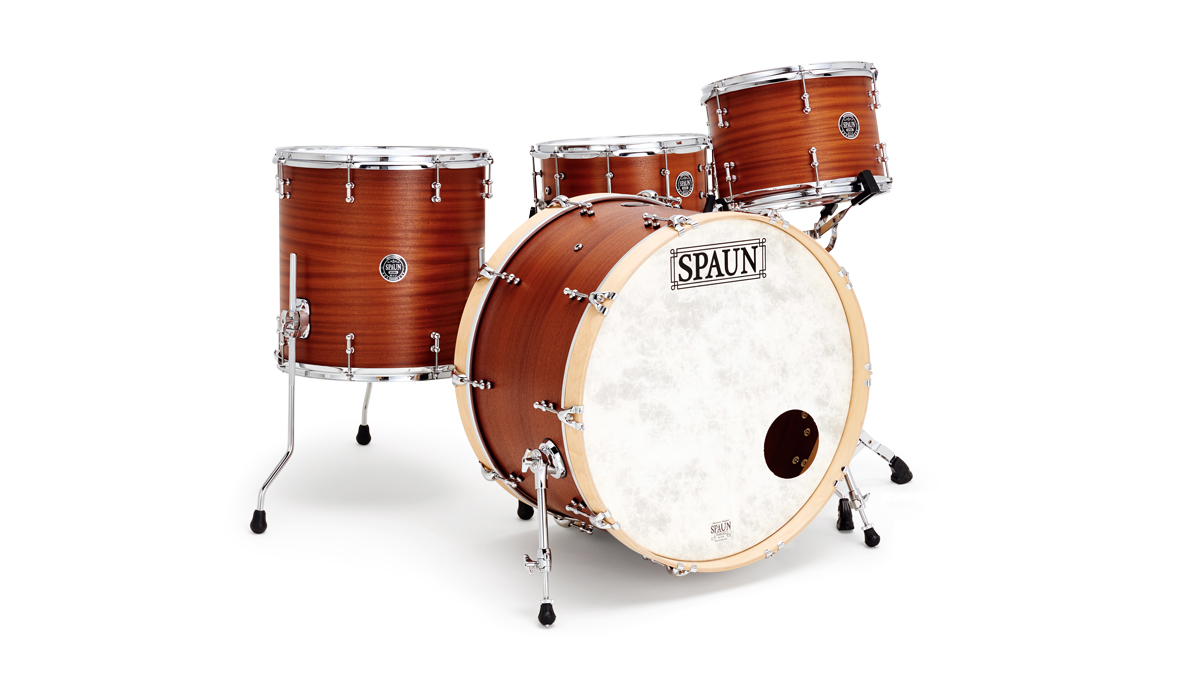MusicRadar Verdict
The Mahogany Series is something of a departure for Spaun into classic vintage territory, boasting a warm, deep and reverberant sound.
Pros
- +
Very well made.
Cons
- -
Not a great deal.
MusicRadar's got your back
The Spaun Drum Company started out 21 years ago in California, making its name with extremely thin (¼") 8-ply shells with special bearing edges that have a symmetrical central sharp peak, along with solid brass button lugs and unlimited finish options.
So this classic Mahogany Series drum kit is a departure, and the reason is that it’s channelling the small but significant retro-movement, taking inspiration from classic drums of the 1940s through 1960s, while at the same time availing itself of modern engineering improvements.
Build
All the shells are 6-ply with an outer and inner veneer of mahogany enclosing a core of four plies of poplar wood. The shells are roughly 5.5mm thick, but they are then held in round by reinforcing rings of 10-ply maple, 6.8mm thick. These re-rings are 1½" deep on the snare and toms and 2" on the bass drum.
Materials-wise, this is a similar construction to the outfits played by 1950s big band drummers, and the first rock’n’roll and blues drummers. We’re talking large drums with thin mahogany shells stabilised by maple re-rings, which recalls Slingerland’s legendary Radio Kings, although you’ll find a greater consistency and accuracy of build with the Spauns over many old Slingerlands.
The classic vintage style is also evident in the sizes offered, which are all straight out of an American 1950/60s catalogue. Thus, bass drums are 14" deep and toms are all classic depths. The review kit is 24"x14", 13"x9" and 16"x16" with a 14"x6½" matching snare.
The bare shells are sourced from leading US shell-maker Keller of New Hampshire. This is par for the course with many American drums. You don’t get the exclusivity of those big companies that build their own shells, but Keller has been supplying numerous companies (some very famous) for 70 years and examination of these shells shows them to be top-notch.

What also counts is how Spaun treats the blank shells it buys in. And right from the beginning Spaun has always spent a lot of time and effort customising its shells.
The vintage theme is carried through to the bearing edges, which are fully rounded in stark contrast to Spaun’s trademark symmetrical 45° church-spire edges. The snare also has shallow ‘Hyper Sensitive’ snare bed dips that are subtly and smoothly cut so as to be hardly noticeable on a machine personally customised by Spaun.
Without giving much away Brian Spaun says the finishing process is proprietary and he won’t discuss specifics. However, the (spray) product used on these shells “is highly favoured by furniture and cabinet manufacturers in the USA”. The mahogany is obviously of premium quality with its regular rich red-brown grain. Mahogany is an open-pored wood so you don’t get the glassy finish of heavily lacquered drums, but you can only achieve a finish like this by spending serious time on hand-sanding and sealing.
An internal paper label attests that Spaun intends this to be an instrument for life and we don’t doubt it. As with other smaller American and UK builders, the hardware is also sourced from outside manufacturers. Spaun has been around long enough to get the fittings personalised, embossed with its own name. This is true of the hefty bass spurs and the snare strainer, while the oval, machined aluminium butt-end has the Spaun logo etched into the clamping plate.
The throw-off is a side-lever design with a tension knob that is quite small and a little stiff. The brass wires are held at 45°, which makes them lie flatter across the bottom head. A special word for the floor tom leg brackets - a thoroughly modern and fool-proof clamp design with sleekly contoured, slot-in memory locks.
Hands On
For those looking to recapture the ‘organic’, ‘analogue’ sound of classic rock, blues and soul - all branches of so-called Americana, not to mention big band swing - this is the kit. It’s the sound of the rumbling, earthy bass drum and fat mambo tom-toms.
The mahogany is just the thinnest of veneers, and combines with the poplar to make a shell that is relatively softer and therefore darker than maple or birch, while the re-rings of hard maple elevate the pitch a tiny fraction. That is a classic formula, as is the rounded - almost flat - bearing edges.
More head area is in contact with the shell, the antithesis of modern pinpoint edges, thereby softening the attack and also drawing out a greater proportion of shell timbre. You certainly notice the difference.
More head area is in contact with the shell, the antithesis of modern pinpoint edges, thereby softening the attack and drawing out a greater proportion of shell timbre
It’s not the hard, digital sound of most current kits, but a darker, deeper and less cutting flavour. Spaun drums have always been uncluttered, lightweight and resonant, yet despite the re-rings and the twin fixing-point brass tube lugs of this Mahogany Series the liveliness does not seem diminished. Quite the opposite.
The review bass drum arrives with its front head and hoop removed for transport. The supplied batter is an Evans EMAD with removable foam damping ring in its plastic perimeter tray.
So before re-mounting the front head we pedal this single-headed drum, and wow! The resonance! A wicked rumble that knocks your socks off. Remove the foam ring and the whole thing shakes and reverberates like a plummeting Dakota DC-3 in an Indiana Jones movie.
Attaching the front head focuses the drum, although that reverberant body is still there and takes some controlling. In fact, there seems no point in having a bass drum like this if you intend to go for a modern, tight, EQ’d sort of thud. It’s a cliché (and, trust me, we get a bit sick of mentioning the great men’s names), but this is the exact drum for a Buddy Rich/John Bonham style open and full, unfettered slam.
But with this drum you can also recreate a pre-amplifiers 1950s vibe with fluffy lambswool beater, softly feathering the batter, which is a distant rumble murmuring away discreetly. The EMAD foam ring is a concession to the modern era, curbing the drum enough to make it close-mic friendly.
There is also a porthole in the Remo Fiberskyn front head, the latter adding yet more warmth and duskiness to the tone. The cavernous nature of the bass drum rolls over to the snare drum, which also rings ferociously. Although naturally deep it is still energetic and is again a drum that proves difficult to play without some sort of damping.
There’s this giant hollow note, like a deep tom - indeed it sounds like it could be an 8" deep tom rather than the actual 6½". The rounded edges contribute much to this, reducing some of the abrasiveness we’re used to with sharp-edged snares.
That leaves the two toms. They are maybe less ‘controversial’, as a deep and boomy sound is great for any tom, right? The Evans G1 is a good choice of coated batter and there is a thick tone, almost like real calf skin.
In fact, the small tom is absurdly fat with a rounded impact, again setting it apart from the usual modern tom sound. So if you want a more broad and rounded beat, here it is.
However, with the 16"x16" tom you have to be careful about getting the top and bottom heads to work together, or you can experience a rudely fruity, flatulent growl! You can see why modern toms are often 16"x14", as they are easier to handle. But a classic 16"x16" is the thing for that effortless depth and bottom rattle.
“A synthesizer that is both easy to use and fun to play whilst maintaining a decent degree of programming depth and flexibility”: PWM Mantis review
“I feel like that song had everything we needed to come back with”: Bring Me The Horizon’s Lee Malia on Shadow Moses, its riff and the secrets behind its tone, and why it was the right anthem at the right time
“I said, ‘Are we sure we can write a song about death?’”: The story of Mike + The Mechanics' classic No.1 The Living Years










